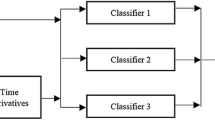Abstract
5In conventional approaches for multi-class pattern recognition using Support Vector Machines (SVMs), each class is discriminated against all the other classes to build an SVM for that class. We propose a close-class-set discrimination method suitable for large class set pattern recognition problems. The proposed method is demonstrated for recognition of isolated utterances belonging to 80 Stop_Consonant-Vowel (SCV) classes. In this method, an SVM is built for each SCV class by discriminating that class against only 10 classes close to it phonetically.
Preview
Unable to display preview. Download preview PDF.
Similar content being viewed by others
References
C.J.C. Burges, “A tutorial on support vector machines for pattern recognition,” Data Mining and Knowledge Discovery, vol. 2, no. 2, pp. 121–167, 1998.
V.N. Vapnik, The Nature of Statistical Learning Theory, Springer, 2000.
J. Weston and C. Watkins, “Multi-class support vector machines,” Tech. Rep. CSD-TR-98-04, Royal Holloway, University of London, May 1998.
P. Clarkson and P.J. Moreno, “On the use of support vector machines for phonetic classification,” in ICASSP, Mar. 1999, pp. 585–588.
P. Niyogi, C. Burges, and P. Ramesh, “Distinctive feature detection using support vector machines,” in ICASSP, Mar. 1999, pp. 425–428.
C. Chandra Sekhar, Neural Network Models for Recognition of Stop Consonant-Vowel (SCV) Segments in Continuous Speech, Ph.D. thesis, Indian Institute of Technology, Madras, 1996.
J.Y. Siva Rama Krishna Rao, C.Chandra Sekhar, and B. Yegnanarayana, “Neural networks based approach for detection of vowel onset points,” in International Conference on Advances in Pattern Recognition and Digital Techniques, Calcutta, Dec. 1999, pp. 316–320.
L. R. Rabiner and B. H. Juang, Fundamentals of Speech Recognition, Prentice-Hall, Englewood Cliffs, 1993.
R. Collobert and S. Bengio, “Support vector machines for large-scale regression problems,” Tech. Rep. IDIAP-RR-00-17, IDIAP, Switzerland, 2000.
T.S. Jaakkola and D. Haussler, “Exploiting generative models in discriminative classifiers,” in Advances in Neural Information Processing Systems, M.S. Kearns, S.A. Solla, and D.A. Cohn, Eds., vol. 11. MIT Press, 1998.
Author information
Authors and Affiliations
Editor information
Editors and Affiliations
Rights and permissions
Copyright information
© 2001 Springer-Verlag Berlin Heidelberg
About this paper
Cite this paper
Sekhar, C.C., Takeda, K., Itakura, F. (2001). Close-Class-Set Discrimination Method for Recognition of Stop_Consonant-Vowel Utterances Using Support Vector Machines. In: Dorffner, G., Bischof, H., Hornik, K. (eds) Artificial Neural Networks — ICANN 2001. ICANN 2001. Lecture Notes in Computer Science, vol 2130. Springer, Berlin, Heidelberg. https://doi.org/10.1007/3-540-44668-0_56
Download citation
DOI: https://doi.org/10.1007/3-540-44668-0_56
Published:
Publisher Name: Springer, Berlin, Heidelberg
Print ISBN: 978-3-540-42486-4
Online ISBN: 978-3-540-44668-2
eBook Packages: Springer Book Archive




